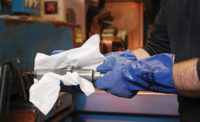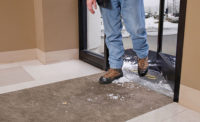Maintaining a clean workplace increases productivity and safety. It also decreases the likelihood of adverse, work-related health issues.
Necessary levels of cleanliness vary by industry. The needs of a food processing facility, for example, are typically going to be more extensive than those of a machine shop.
Determining the optimal level of cleanliness to meet health, safety and production needs allows facilities to create cleaning, sanitizing and disinfecting regimens that are realistic and not overly burdensome. Unlike many situations where going “above and beyond” is a good thing, over-cleaning may be wasting time and resources.
Clean
Cleaning a surface removes visible dirt, dust and debris. Sweeping floors, washing windows and wiping spills from countertops are examples of cleaning. When facilities establish routine cleaning schedules and adhere to them, they reduce the likelihood of dirt, spills and clutter creating unsafe working conditions.
Cleaning is appropriate for surfaces that have a low risk of contamination. Usually, if cleaning is done by hand, it involves some type of soap or detergent and a mop or wipe. Cleaning can also reduce the number of germs, mold and fungi on surfaces, but does not effectively kill them.
Because cleaning removes dirt and grime, it may be all that is necessary in some areas. For example, floors in office hallways or lobbies generally don’t need to be sanitized or disinfected.
The chance for dirt and dust to become airborne is minimized when surfaces are kept clean. Cross-contamination is also minimized.
In addition to these benefits, cleaning is necessary step before sanitizing or disinfecting a surface. The effectiveness of sanitizers and disinfectants is lessened when a surface is physically dirty.
Sanitize or disinfect?
Although the terms “sanitizing” and “disinfecting” are often used interchangeably, they are different processes with different effectiveness. The EPA regulates both sanitizers and disinfects as pesticides under the Federal Insecticide, Fungicide, Rodenticide Act (FIFRA). Under this set of regulations, parameters are established for labeling a product as a sanitizer and/or disinfectant, based on a product’s effectiveness.
If a product will be used to sanitize a food contact surface, it must be 99.999 percent effective in 30 seconds. For non-food contact surfaces, sanitizing agents must be 99.9 percent effective in 30 seconds. Disinfectants must destroy or inactivate microorganisms in ten minutes. Products can be dual-registered as both a sanitizer and a disinfectant if they meet the respective criteria of both.
Sanitize
Sanitizing lessens the number of germs on a surface to make it safe for food or human contact. That means that sanitizers will reduce, but will not kill, all of the bacteria, viruses or fungi on a surface.
To be effective, sanitizers need three things. First, they must be used on clean surfaces that have no physical dirt present. Second, they must be mixed and used in the right concentrations. Third, they must have sufficient dwell time.
Sanitizers usually don’t contain soaps or detergents, so they are not effective in physically removing dirt and debris. Using sanitizing solutions as cleaners will cause them to lose their effectiveness more quickly than if the solution is reserved solely for sanitizing.
Products that will be used to sanitize surfaces should be used according to the package directions. More is not always better, because it can leave residues on surfaces and possibly cause corrosion.
Chlorine bleach and Quaternary ammonium compounds (quats) are two of the most commonly used sanitizing agents. Bleach solutions should be made from food-grade bleach with no fragrances or other additives, and are commonly mixed at a ratio of one tablespoon to one gallon of water. Quat solutions are typically mixed to either 200 or 400 parts per million with water. Although these are commonly accepted dilution ratios, the package directions must always be followed for the best efficacy.
Package directions on sanitizers will also specify how long the product needs to dwell on a surface before it can be wiped off or before it dries. If a sanitizer has as dwell time of 60 seconds, this means the surface needs to remain wet with the sanitizing solution for at least 60 seconds. Drying the surface with a towel prior to the 60 seconds will defeat the purpose of sanitizing the surface.
Disinfect
When bacteria and viruses need to be killed, the surface that is contaminated should be disinfected. Like sanitizers, disinfecting isn’t intended for cleaning a surface, and using a disinfectant on a physically dirty surface will reduce its effectiveness.
Washrooms, sinks, door knobs, faucets and other surfaces that are touched frequently are examples of surfaces that may need to be disinfected. Food service counters or tables where raw meats are handled are another example
Because disinfectants are killing germs, they require a longer dwell time. This time will be listed with the usage instructions, but is usually between 30 seconds and ten minutes.
It may be tempting to just disinfect everything instead of sanitizing. After all: it kills germs, whereas sanitizing only reduces their volume. But because disinfecting solutions are stronger than sanitizing solutions, they are more likely to corrode surfaces, cause skin irritation or trigger asthma and other health conditions.
Review what types of surfaces need to be cleaned throughout the facility, and have an objective for how clean each needs to be to help simplify cleaning operations. It can also save time while still ensuring optimal health for everyone who uses and works in each area.


